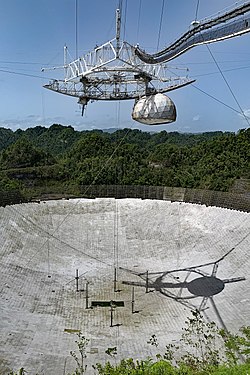Arecibo Telescope
The Arecibo Telescope is now destroyed by a collapse.[1]
The radio telescope was a 305 m (1,000 ft) spherical reflector dish built into a natural sinkhole at the Arecibo Observatory which was completed in November 1963.
For more than 50 years, the Arecibo Telescope was the world's largest single-aperture telescope. In July 2016 the Five-hundred-meter Aperture Spherical Telescope (FAST) in China was put into service.
On 19 November 2020, the National Science Foundation announced that they would close and dismantle the telescope.[2][3][4] On 1 December 2020, the telescope collapsed.[5][6]
Arecibo Telescope Media
The Arecibo message with added color to highlight the separate parts. The actual binary transmission carried no color information.
References
- ↑ BBC News. [1]
- ↑ "NSF begins planning for decommissioning of Arecibo Observatory's 305-meter telescope due to safety concerns [News Release 20-010]". www.nsf.gov. Archived from the original on November 19, 2020. Retrieved November 19, 2020.
- ↑ Clery, Daniel (November 19, 2020). "Famed Arecibo telescope, on the brink of collapse, will be dismantled". Science | AAAS. Archived from the original on November 19, 2020. Retrieved November 19, 2020.
- ↑ Witze, A (November 2020). "Legendary Arecibo telescope will close forever - scientists are reeling". Nature. 587 (7835): 529–530. Bibcode:2020Natur.587..529W. doi:10.1038/d41586-020-03270-9. PMID 33214727.
- ↑ "Giant Arecibo radio telescope collapses in Puerto Rico". The Guardian. 1 December 2020. https://www.theguardian.com/world/2020/dec/01/arecibo-radio-telescope-collapses-puerto-rico. Retrieved 1 December 2020.
- ↑ Coto, DÁNICA (December 1, 2020). Huge Puerto Rico radio telescope, already damaged, collapses. Associated Press. https://apnews.com/article/puerto-rico-0da6abb251f455977bf0c752348e712e. Retrieved December 1, 2020.


